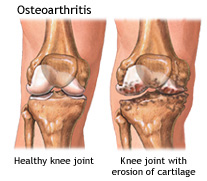 Every year you feel the nagging pain more than ever before. Humid weather makes your bones ache. This summer is the worst. You won’t be joining the company running club, you’ve decided. Knee pain is definitely slowing you down.
 You have osteoarthritis. You’re one of more than 20 million adults with a disease that destroys the slippery cartilage that cushions your joints, making your bones grind together like the Earth’s crust on a fault line.
You’re getting older (who isn’t?), but your pain shouldn’t keep you from staying active. Fact is, joining that running club (at least to walk) is one of the best things you can do to keep your pain from nagging you more. And that’s not all you can do.
It's up to youOsteoarthritis itself is not life-threatening, but people with this disease can watch their quality of life significantly slip away from pain and loss of mobility. Only heart disease has a greater impact on work. But it doesn’t have to be that way.
 To keep your joints healthy, try the following:
- Lose weight. If you’re overweight, you’d be amazed at how you can reduce the shock on your knees through weight loss. Knees, work horses that they are, sustain an impact three to five times the weight of your body when you go down a flight a stairs. That’s a serious pounding for anyone. (Try this: run up a hill, then run back down, and see which hurts your knees more. On second thought, take our word for it: Going downhill hurts more.) Research suggests, however, that losing as few as 11 pounds may cut your risk of osteoarthritis of the knee in half. The more weight you lose, the better.
- Ice is Nice, Heat Also Helps. Take care of injuries. If something hurts, don't push yourself through the pain. If you do, you might make an injury worse. When a joint swells (particularly the knee) applying ice for 20 to 30 minutes can be effective. People with arthritis in their hands can relieve pain with hot soaks and warm paraffin wraps. You can treat osteoarthritis of the hip with heating pads.
- Bulk Up. Research shows lifting weights creates denser bones and builds stronger muscles that help stabilize and protect joints. Strength training may even be just as potent for relieving the pain of arthritis – if not more potent – than medicines, according to the Centers for Disease Control and Prevention.
- Get moving! Joints need motion to stay healthy. Long periods of sitting around can cause an arthritic joint to stiffen, and the surrounding tissue to shrivel. A moderate exercise program with low-impact aerobics (remember that running club?) and power and strength training may help you, even if exercise does not slow down the progression of your disease. And don’t forget to always check with your doctor before starting any type of exercise routine. You wouldn’t want to do further damage if your joints need medical attention.
Think of it this way: Don’t let the pain rule you; rule the pain! You’ll improve your lifestyle and have a new sense of purpose. Who wants the skill of telling the weather with their knees, anyway? Even if you do think you usually have better success than the local weather guy….
|